How to Fix Windows Activation Error 0x8007267C?
Several Windows 10 users have been encountering the 0x8007267C error code when attempting to activate a Windows 10 computer following the official channels. In the majority of cases, affected users are reporting that the key they’re trying to activate it’s perfectly valid.
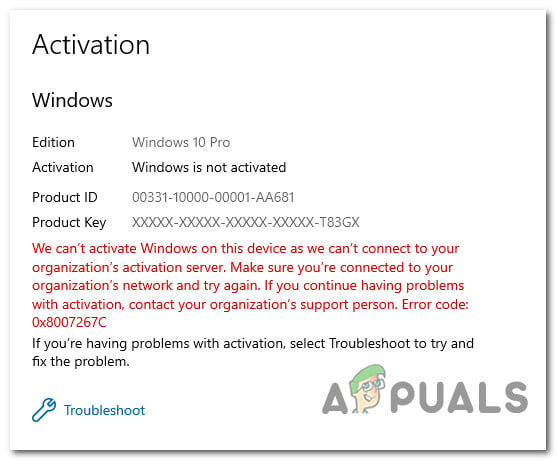
After investigating this particular issue thoroughly, it turns out that there are several different underlying cause that might trigger this particular error code. Here’s a list of potential culprits that might be responsible for this particular error code:
- Common Activation inconsistency – According to some affected users, you can expect to encounter this issue in those instances where the activation is hindered by a common inconsistency that your Windows installation knows how to fix automatically. In this case, all you need to do is to run the Activation troubleshooter and apply the recommended fix.
- Corrupted DNS Cache – Another fairly common culprit that might cause this activation error is an inconsistency caused by a corrupted DNS cache. In this case, you should be able to resolve the problem by flushing your current DNS cache from an elevated Command Prompt window.
- Bad DNS Range – Depending on your ISP, you can also expect to see this error occurring in instances where your Internet Service Provider has assigned you a bad DNS range that the activation server rejects. In this case, you should be able to circumvent the apparition of the error by migrating your DNS to the equivalents provided by Google.
- Different type of activation is required – If you’re trying to activate a key that was originally migrated from Windows 7 or Windows 8.1, you might need to use the SLMGR utility in order to activate it successfully. If this scenario is applicable, you should switch to a MAK activation attempt.
- An underlying issue with your license key – Under certain special circumstances, you might need to get in contact with a Live Microsoft support agent and ask them to activate the license key remotely on your computer.
Now that you know every potential culprit that might be responsible for the apparition of this error code, here’s a list of methods that were actually confirmed by other affected users:
Method 1: Running the Activation Troubleshooter
More often than not, you can attribute the apparition of this issue to some kind of licensing inconsistency that is affecting your computer’s ability to communicate with the activation servers.
If you find yourself in this scenario, our recommendation is to start this troubleshooting guide by running the Activation Troubleshooter and applying the recommended fix. Most user reports flagging this issue have reported that the problem only started occurring after they made a major hardware change (most commonly replacing the motherboard).
If this scenario is applicable in your particular scenario, follow the instructions below to run the Activation Troubleshooter and apply the recommended fix:
- Open up a Run dialog box by pressing Windows key + R. Next, type “ms-settings:activation” and press Enter to open up the Activation tab of the Settings menu.
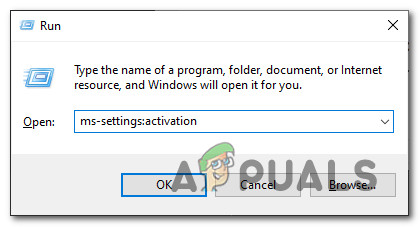
Opening the Activation Troubleshooter - Once you’re inside the Activation tab of the Settings app, move over to the right-side pane and click on the Troubleshoot button under Activate Windows.
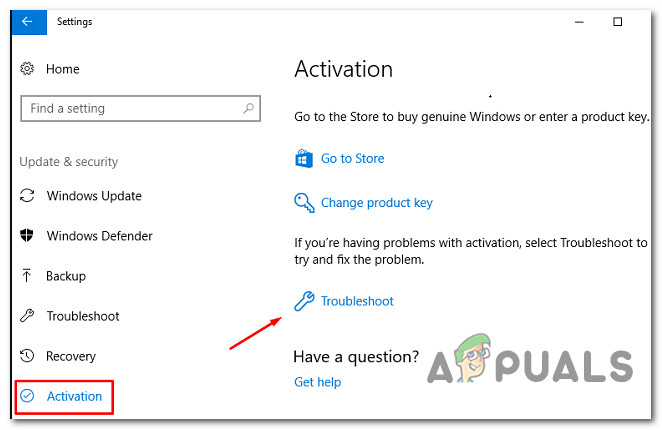
Running the Activation Troubleshooter tab - After you manage to launch the troubleshooter, wait until the initial scan is complete, then click on Apply this fix if a viable repair scenario is identified.
- If the fix is successfully applied, reboot your computer and see if the problem is fixed once the next startup is completed by attempting to activate the license key once again.
If you still end up seeing the same 0x8007267C error is still occurring, move down to the next potential fix below.
Method 2: Flushing your DNS Cache
Since this particular error code can be translated to ‘No DNS servers configured for local system.‘, you should start this troubleshooting guide by flushing your current DNS (Domain Name Server) in order to resolve the majority of network inconsistencies that might be preventing your computer from connecting to the Activation server.
If this scenario is applicable, you should be able to fix the problem by opening an elevated Command prompt and running a series of commands that will successfully flush and renew your current DNS configuration.
Note: Going this route will not cause any underlying changes in regards to how your network operates, The only thing that this does is it ends up clearing the current DNS-related temp data and forces the assignment of new DNS information.
In case you haven’t tried fixing the 0x8007267C error by flushing your current DNS yet, follow the instructions below:
- Press Windows key + R to open up a Run dialog box. Next, type ‘cmd’ inside the text box and press Ctrl + Shift + Enter to open up an elevated Command Prompt with elevated access. When you’re prompted by the UAC (User Account Control), click Yes to grant admin access.
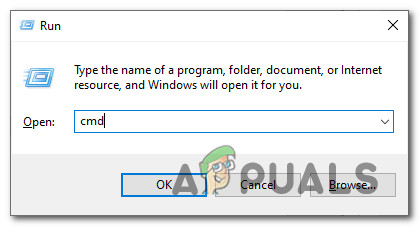
Opening the CMD prompt - Once you’re inside the elevated Command Prompt, type the following command and press Enter to flush the current DNS cache:
ipconfig /flushdns
- Wait until the operation is complete. You should get a confirmation op up telling you that the DNS has been successfully refreshed.
- After you see the success message, type the following commands and press Enter to renew the current IP configuration:
ipconfig /renew
- Once the second command is processed successfully, attempt to activate your Windows installation once again and see if the issue is now fixed.
If flushing your DNS cache didn’t allow you to fix the issue, move down to the next potential fix below.
Method 3: Migrating to Google DNS
Even if a simple didn’t fix the activation error 0x8007267C in your case, that doesn’t mean the problem is not DNS related.
It’s also possible that the current DNS range used by your ISP (Internet Service Provider) is no longer accepted by the MS activation server. If you find yourself in this particular scenario, you should be able to fix this problem by changing the default DNS range with the equivalents supplied by google.
To make matters easier for you, we’ve walked you through the entire process. Follow the instructions below:
- Press Windows key + R to open up a Run dialog box. When you’re inside the Run prompt, type ‘ncpla.cpl’ and press Enter to open up the Network Connections menu. If you’re prompted by the UAC (User Account Control), click Yes to grant admin access.
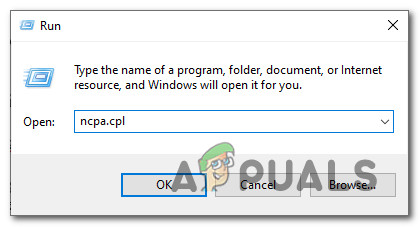
Opening the Network Connections tab - Once you’re inside the Network Connections window, right-click on Wi-Fi (Wireless Network Connections) and choose Properties from the context menu. If you’re using the wired connections tab, right-click on Ethernet (Local Area Connection) instead.
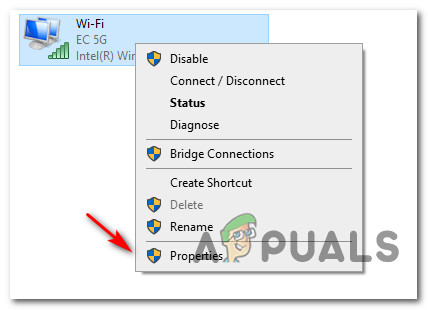
Accessing the Properties screen of the active network Note: When prompted by the UAC prompt, click Yes to grant admin access.
- Once you’re inside the Ethernet or Wi-Fi menu (depending on your type of connection), then click on the Networking tab and find the section that says This connection uses the following items.
- After you manage to identify the correct connection, click on Internet Protocol Version 4 (TCP / IPv4), then click on the Properties button.
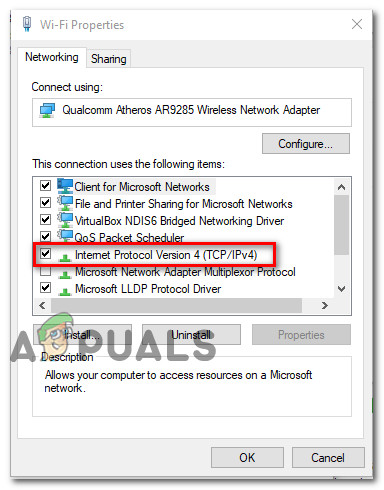
Accessing the IPv4 settings - Inside the Internet Protocol Version 4 settings, go ahead and click on General, then enabling the box associated with Use the following DNS server address.
- After you get to the next screen, replace the current values of Prefered DNS settings and Alternate DNS server with the following values:
8.8.8.8 8.8.4.4
- Save the changes to enforce the DNS range, then return to the Initial Properties screen and modify the DNS range for Internet Protocol Version 6 (TCP/IPv6) with the following Preferred DNS server and Alternate DNS server values:
2001:4860:4860::8888 2001:4860:4860::8844
- Save the changes by hitting the Apply button, then restart your computer and see if the issue is now resolved by attempting to activate your Windows license once again.
If the same problem is still occurring, move down to the next potential fix below.
Method 4: Using MAK (Multiple Activation Key)
Once you’ve ensured that the DNS server you’re currently connected to is not responsible for the apparition of the 0x8007267C error, one last thing you can try before requesting specialized support, you can switch to a MAK product key to activate your volume license installation.
Several affected users that were dealing with the same problem have confirmed that using the SLMGR utility was the only thing that allowed them to fix the issue.
If you haven’t tried avoiding this error via SLMGR yet, follow the instructions below to use the Software Licensing Management Tool to try to activate your Windows 10 license key:
- Open up a Run dialog box by pressing Windows key + R. Next, type ‘cmd’ inside the text box and press Ctrl + Shift + Enter to open up a Run dialog box. When you’re prompted by the UAC (User Account Control), click Yes to grant admin access.
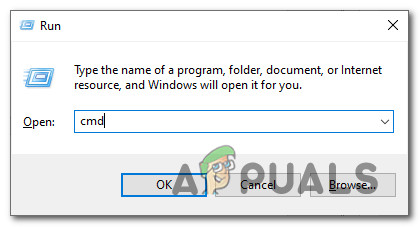
Opening the CMD prompt - Once you’re inside the elevated CMD prompt, type the following commands and press Enter after each one:
slmgr /ipk *License Key* slmgr /ato
Note: Keep in mind that *License Key* is only a placeholder for the actual license key that you are trying to activate. So, replace the placeholder above with your Windows 10 license key.
- Once both commands are processes successfully and you get the confirmation message, reboot your machine and wait for the next startup to complete before checking if the activation has been successful.
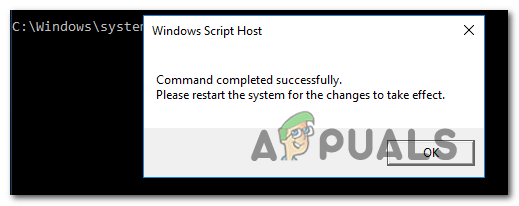
Activating the license key via MAK
In case utilizing MAK didn’t allow you to avoid the apparition of the 0x8007267C error code, move down to the next potential fix below.
Method 5: Contacting a Microsoft Support Agent
In case none of the methods above have worked in your case and you’ve made sure that you’re using a viable Windows 10 licensed key, your last resort should be to get in contact with a LIVE Microsoft agent.
Keep in mind that there are multiple ways to get in contact with a Microsoft Live agent, but the most common and quickest route is to rely on the official MS contact page and use the chat option of the Get Help app.
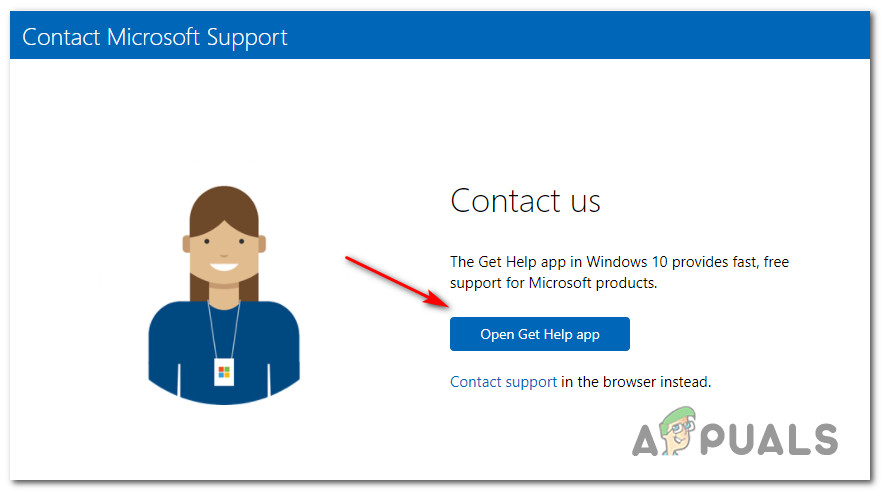
Once you have successfully followed the instructions to get in contact with a live agent, be prepared to answer a couple of routine questions to confirm that you are the owner of the license.
After everything checks out, the support agent will try to activate the key on your computer remotely.




